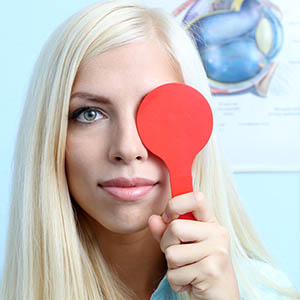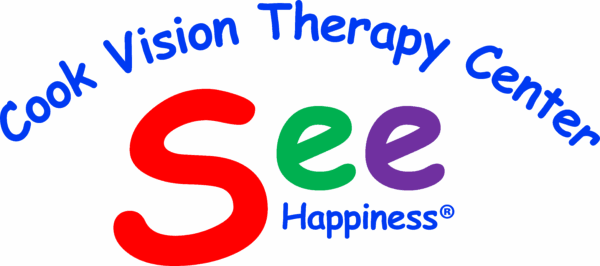Vision Therapy Evaluation
What is vision therapy?
Vision therapy uses specialized instruments and expertise to increase the brain’s ability to convert light entering our eyes into action. Learning to read, reading to learn, completing homework quickly, working comfortably on a computer, golfing or playing baseball, driving at night, not worrying that your eye may cross in front of others, improving depth perception despite a lazy eye—seeing to perform these actions can frequently be improved by vision therapy. But are you a candidate for such improvements? That’s where our vision therapy evaluation comes in.
Call and speak to our patient consultant to see if you are a candidate for vision therapy.
Our Vision Therapy Evaluation
Our evaluation and consultation typically take about 2 hours of your time and includes dozens of tests related to the use of your eyes for comfortable, accurate, efficient two-eyed seeing. We listen carefully to what you have to say.
Time and again, our doctors understand things that have been ignored or dismissed during past routine eye exams. Using demonstrations and simple language, we explain what your evaluation tells us about the use of your eyes and about using vision therapy to change your seeing, and life.

Case History
Your first step is to fill out a case history providing information on how vision is affecting life in the areas of clear seeing, comfort, reading, work, school, sports, coordination, attention, and relationships. For older patients the case history will include questions about driving. Go to Screening Forms and print out a case history form for yourself or child. Fill this out and bring it with you to the evaluation. We will use the information to tailor the evaluation to your needs.
What to Expect During Your Vision Therapy Evaluation
Our 2-hour comprehensive evaluation pinpoints visual inefficiencies through dozens of tests, tailored to your unique needs. Here’s how we help:
-
In-Depth Case History:
-
Share how vision impacts your life (e.g., reading, work, sports, driving).
-
Pro Tip: Download our Vision Therapy Screening Forms and bring them to your appointment for a streamlined process.
-
-
Expert-Led Testing:
Our doctors specialize in uncovering overlooked issues, using simple demonstrations to explain findings. Whether it’s dyslexia, eye strain, lazy eye (amblyopia), or post-stroke recovery, we focus on your goals. -
Clear Recommendations:
By the end, you’ll know if vision therapy is right for you and how it can transform daily tasks like reading, driving, or sports.

Testing the Visual Abilities
Depending on what the case history reveals, we may stress testing related to reading or dyslexia, eye strain or double vision, crossed or lazy eyes, or traumatic brain injury or stroke. We will select from the visual abilities fully explained in Dr. Cook’s books, When Your Child Struggles, Visual Fitness, and The Shape of the Sky. Eight of the main abilities are summarized below:
1. Seeing Little: 20/20 Eyesight
If at twenty feet you can see the same six letters on an eyechart that others with normal eyes can see at twenty feet, then you have “20/20 eyesight.” 20/20 eyesight—whether with or without glasses—is far from perfect vision. It fails to guarantee speed, comfort, accuracy, endurance, efficiency, or seeing the big picture.
2. Eye-muscle Coordination
Failure to coordinate the fourteen muscles of the eye can cause 1) double or blurred vision, 2) fatigue or loss of concentration and comprehension during reading, 3) reduced 3D vision for night driving and ball sports, or 4) crossed or lazy eyes (strabismus or amblyopia).
3. Eye Control
Eye Control is a measure of visual attention. When eye control is inaccurate, seeing is inaccurate. Failure to keep eyes on the ball, maintain eye contact during a conversation, or guide a pen or pencil can all signal poor eye control.
4. Visual Tracking
How quickly and accurately can eyes move within a word or across a line of print? During reading, poor visual tracking can increase loss of place, confusing one word with another, careless errors, or the need to use a finger as a pointer.
5. Visual Perception
An artist can perceive relationships between shapes and colors well enough to paint a picture. A child with a vision perception problem may struggle to distinguish between a “b” and a “d,” align columns in math, or focus on and interpret the correct details when learning.
6. Eye-hand-body Coordination
Hands and bodies teach eyes to see. Thereafter, eyes guide bodies. Eye-body coordination allows keeping words equally spaced and on the line when copying. It supports balance, throwing or catching a ball, and moving about without tumbles, bumps, or bruises.
7. Visualization
Whether we are picturing a spelling word, a story being read, or a goal in life, the mind’s eye enhances our learning from the past and our planning for the future. Visualization guides the portion of our thinking formed by pictures instead of words. To “see” is to understand.
8. Seeing Big: Central-Peripheral Integration
To ignore either the details or the big picture is to be blind to half the world. Some never adapt to the detailed, sequential world of books. Others excel at the near, flat world, only to struggle with the distant, simultaneous, three-dimensional world of ball sports and night driving. While a page of print may require hundreds of fixations, the broad side of a barn should be captured in a single glance. The viewer with an efficient, developed visual system flows between the details, big picture, or both as the task requires.
Are You a Candidate for Vision Therapy?
During your evaluation, the doctors will center on the visual abilities most related to your visual goals. At the end of the evaluation, the doctors will share what was found and if you or your child is a candidate for vision therapy.
FAQs About Vision Therapy Evaluations
-
How is this different from a routine eye exam?
We test functional vision skills (e.g., tracking, coordination) beyond basic eyesight, often missed in standard exams.
-
Can adults benefit?
-
What if I have a lazy eye or traumatic brain injury?
-
How soon after the evaluation can I start vision therapy?
-
How long does vision therapy take to show results?
-
Do I need a referral from my optometrist?
-
What should I bring to the evaluation?
-
Do you offer resources to learn more before my evaluation?
-
What is a vision therapy evaluation?
-
How is a vision therapy evaluation different from a routine eye exam?
-
Who should consider a vision therapy evaluation?
-
What happens during a vision therapy evaluation?
-
How do I know if I or my child needs vision therapy?
-
What are the next steps after a vision therapy evaluation?
-
What symptoms indicate I might need vision therapy?
-
What types of tests are included in a vision therapy evaluation?
Check Out Our Resources
Dr. Cook’s Publications:
- Authored books VISUAL FITNESS and WHEN YOUR CHILD STRUGGLES.
- Published articles in top optometric journals.
- His article “Eyesight, infinity and the human heart” was voted “Best Non-Technical Article” by the Association of Optometric Editors.





